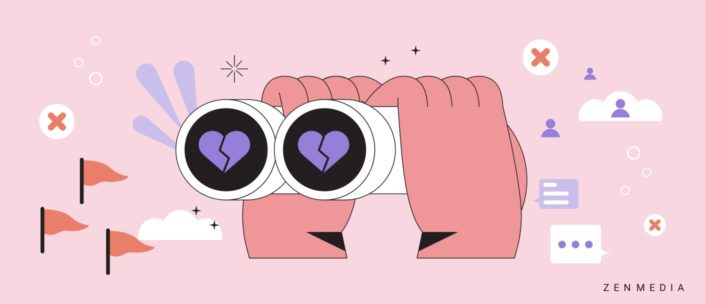Let’s talk branding.
As marketers, we carefully craft brands that we believe will attract buyers. The colors, the logo, the voice, the messaging, the story—so much goes into it.
So here is a frustrating fact: Customers don’t think about your brand in terms of your product or services.
They care about what your brand says about them. It’s not about you and your company—it’s about how your brand makes your customers look. And no, we’re not just talking about fashion brands.
How do buyers choose brands?
Today, just about every product or service is at the fingertips of its buyers with less than a moment’s notice. Now, we know the buyer’s journey has gotten longer—especially in the B2B space—but that isn’t due to lack of accessibility. Businesses everywhere are making sure their products are available with a click or a signature on an online contract. They’re creating websites and generating content to explain why their brand is best.
And here’s the truth—it isn’t so much about which product is best. A lot of the time, buyers decide based on what using a certain product says about them. Sometimes it means choosing the product with the largest market share because, true or not, most consumers assume that the brand name companies—the ones we all know—are the best.
The more visible a brand is, the more credible people believe the brand to be. The more credible a brand is believed to be, the more likely buyers are to choose that brand.
Related reading: Here’s How to Build Trust In Your Brand in 2022
In a nutshell:
Visibility → Credibility —> Profitability
What does this look like in action?
“Nobody ever got fired for buying IBM.”
In the ’70s, when IBM owned the largest share of voice in the tech space, its credibility was built on the fact that it was the status quo. Everyone went with IBM because it was the norm—it was the safe bet. And buyers still want the safe bets—especially in the B2B.
But with the advent of social media, visibility is significantly more extreme now than it was in the 70s. We aren’t just watching or listening to the occasional commercial and using that as the basis for visibility and, therefore, credibility. Now, we are looking at their website, their social media profiles, the profiles of their CEO, president, founders, leadership—and more. Now, we’re seeing what other customers say—do they have good reviews? Testimonials? Social proof?
Now, buyers need to know if using your brand will make them look good.
Do you make your customers look good?
Today, public perception isn’t just about whether your products work, are high quality, and so on. They encompass your values, your vision, and the actions you take. You can have the best products globally, but if it is revealed that you have unethical business practices—you won’t make your clients look good.
Bad press = low credibility = low profitability
So how do you make your clients look good?
A big part of it is simply being visible.
As we noted before, visibility leads to credibility, which leads to profitability (i.e., sales).
Strong press placements, social media engagement, a website with a robust search rank, paid ads to find and route traffic to your page, and more—a holistic Mixed Marketing Model strategy is step one to gaining visibility. Then, as more of your target audience use your services—especially if they are vocal and positive about using those services—that type of visibility boosts your brand’s credibility.
Your prospects will be encouraged to use your services because their peers use your services.
Related reading: Why Sales Collateral Should Be Part of Every B2B Marketing Strategy—And How To Get It
But even if you have strong visibility, that doesn’t always translate to making your customers look good. There’s more to it than just being visible and having customers. Consumers and businesses alike want to know that the companies they patronize and partner with are like-minded—that they have a great culture, are responsible and trustworthy, are ethical and innovative, and are cool, even.
Now, each consumer and business will have its own set of standards and perceptions on what is vital in terms of what will make them look good, and that’s why knowing your audience is so important. Knowing what your audience values is key to understanding how to make them look good.
Nike decided that their sports fan audience, especially those in the Millennial and Gen Z age ranges, would connect with having a semi-controversial spokesperson—Colin Kaepernick, the former San Francisco 49ers quarterback who famously kneeled during the national anthem to protest police brutality. Kaepernick’s choice as spokesperson was a high-risk move considering that in 2016 he was named the most disliked player in the league.
But Nike’s marketing team decided to take that risk, believing that it was a high-risk, high-reward situation where they would come out ahead. They targeted online paid ads (as opposed to television ads) to reach their target audience base—Millennials and Gen Zers who polled as being favorable of Kaepernick. And while Nike’s shares fell in the first few days following chatter about the ad campaign, sales overall went up by 10% when the ad campaign launched. Nike had accurately identified that their core audience segment would come out in droves because now sporting Nike gear says something about the wearer.
They also faced a serious backlash, with those who no longer felt represented and connected to the brand boycotting and even burning their Nike gear.
During this era, where things are uncertain, and consumers and businesses alike are still determining how to navigate the personal and professional realms, it’s more important than ever before for brands to know how to connect with and resonate with their audiences.
For those who fail to connect with their audience, it’s time for a pivot, or “brand repositioning.”
What Is Brand Repositioning?
So you’re struggling to connect with your audience.
Maybe you used to resonate with them, but as society shifted, you remained stagnant, and now your audience has moved on. Or maybe your original brand just didn’t stand out from the crowd. Whatever the reason, it’s time to think about repositioning.
Brand repositioning is an effort made by a company to update its brand status, associations with persons or other companies, their overall personality, or their core message.
While it can be hard to let go of an old concept or start from scratch, repositioning is a natural part of marketing. It’s our job as marketers to listen, watch, and learn so that as trends shift and buyer behaviors change, we can reposition our brands so that they can best connect with our audiences. Some of the most well-known companies have gone through massive repositioning, and the payoff has been massive.
Think about Old Spice, for instance. Old Spice’s key demographic was older men, and it was a scent many associated with Dad or even Grandpa. When Old Spice wanted to move into a younger market, they repositioned their brand, moving from old man to manly man (in the most humorous and fun sense).
Brand repositioning, when done right, is about understanding what makes your brand special, what will resonate with your audience, and then connecting the dots. But it can also be about removing elements of your brand that aren’t intrinsically special or indicative of who you are as a company, or elements that don’t resonate or appeal to your audience. This could mean something as simple as changing the messaging or adjusting the color palette. Or it could mean something more drastic like cutting ties with spokespeople, influencers, or other business partnerships that no longer appeal to your audience.
Companies Who’ve Cut Ties With Brands
It’s not just individuals who want your brand to make them look good; it’s also businesses—especially if your customers are businesses (hello, B2B friends). As you partner with and cater to other companies, you need to be cognizant of how using your product makes them look—and vice versa.
Do you share values, vision, and vibe? Does your partnership make both of you look good to other potential customers?
IKEA decided to cut ties with Amazon in 2020 when Amazon discontinued a smart lighting project, and several other brands (like the aforementioned Nike) have similarly cut ties with the retail giant. It is hard to say whether this move will pay off in the long run, as supply chain issues and market volatility make it hard to determine long-term outcomes. But the message is clear. IKEA doesn’t feel that Amazon holds the same vision and values, so partnering with Amazon doesn’t make them look good.
While not a company per se, this same method of cutting ties is often used to show political alignment. The most obvious example: amidst the Russian invasion of Ukraine, dozens upon dozens of companies have fully suspended business with and/or in Russia. Some of the businesses cutting ties include:
- Spotify
- Nestlé
- Sony Pictures
- YouTube
- Disney
- Marriott
- Goldman Sachs
- And on and on
Companies Using CSR to Make Their Customers Look Good
On the flip side, companies are also looking to create ties and adopt strong partnerships with organizations and companies that will reflect positively on them. Companies are striving to become greener, more diverse, and more charitable. And to accomplish this look, they are publicizing their CSR initiatives.
What is CSR?
Corporate social responsibility is a form of business self-regulation and governance. When a company has a CSR initiative or program, they generally make a commitment to regulating their own practices to ensure that they fall within specific ethical guidelines. In some cases, CSR initiatives also include donating to and/or otherwise furthering philanthropic and humanitarian goals.
CSR initiatives are a great way to make your ethical stances known and help make your customers feel good about using your products or services. One of the biggest CSR initiatives we are seeing right now is the commitment to going green. Some of the biggest brands in the country have made green commitments—one of the most interesting? McDonald’s.
As a business that runs on being fast, single-use, and disposable, when McDonald’s announced that they were going green, there was some surprise. But the move is garnering a lot of attention, and it is setting them up as a fast-food company that is taking a stand and setting a new standard for fast food. The fast-food giant took an oath to go green by focusing on overall energy consumption, like energy-efficient appliances and parking lots that can support hybrid vehicles. They claim that by 2025, all of their packaging and materials will be renewable and recyclable or made from certified recycled materials.
It’s not a terribly hard concept to understand. People want to work with and buy from brands that are doing good things so that they can stand in the “halo” of that good. It’s called the halo effect.
What is the Halo effect?
The halo effect is when the positive impression of one element “shines” onto those in close proximity to it. For example, if you surround yourself with impressive people, you come across as impressive due to the company you keep. If your brand is associated with philanthropic and humanitarian efforts, then those that use your brand’s products will bask in the halo of “good” that is associated with your brand’s efforts.
Does your brand have a halo?
Are we headed for a break-up?
The best way to prevent consumers from breaking up with your brand is to see the signs and address them (hello, repositioning) before your audience moves on.
Tracking metrics to identify dips in social media engagement, adjustments to website traffic patterns, lead generation decline, and conversion rate drop-off are all obvious signs that your brand may be on track for a break-up.
But the best method for understanding how your audience feels about you? Listen to them.
Related reading: The Top 14 Social Media Tools for B2Bs in 2022
Social listening will help you identify general thoughts about your industry, and reading reviews is a great way to gain direct insights into the customer experience.
In the end, not everyone will gravitate toward your brand, and some consumers may still break up with you, even if you have the biggest, brightest, most visible halo around. The key is to keep learning about your audience and finding ways to connect your differentiators to the things that resonate with them.
Want help saving the relationship? Unsure if your brand makes your customers look good? We can help.





